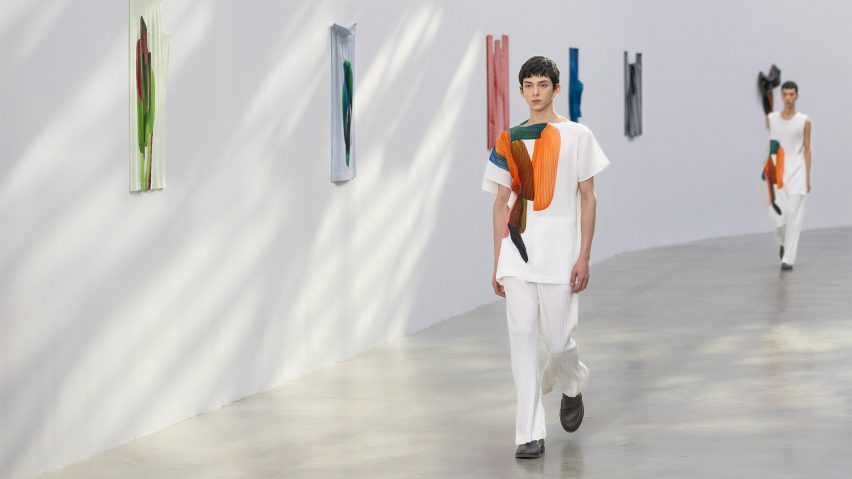Coats that convert into cushions and scarves that can be worn as hats feature in the latest collection from fashion brand Issey Miyake, created in collaboration with French designer Ronan Bouroullec.
Presented during the Homme Plissé Issey Miyake Autumn Winter 2024 menswear show in Paris, the collection reinterprets Bouroullec's growing body of abstract drawings into a collection of garments and accessories.
The collaboration with Homme Plissé Issey Miyake, an offshoot of Japanese fashion house Issey Miyake, comes after Bouroullec told Dezeen in an interview last year that he had turned down numerous requests from fashion designers who were keen to use his artworks.
"I didn't want my drawings to be used as patterns," he said at the time.
Instead, the new collection focused more on translating the spirit of the various artworks, according to the design team at Homme Plissé Issey Miyake.
"The interpretation of creative visuals goes beyond turning them into motifs and patterns," the team explained.
"The body of work acts as ingredients to be incorporated into the design and making of the collection, forming a harmonious creative process."
The gradient strokes of Bouroullec's felt-tip drawings, for example, were transposed onto garments fashioned from the brand's signature pleated fabric, which were cut into asymmetrical silhouettes to correspond to the blank spaces found on the page.
Elsewhere in the collection, these felt-tip brush strokes were silkscreen-printed in layers onto all-white outerwear or translated into scarfs made from multi-coloured yarn.
Strategic head and arm holes were added to these scarfs, so they can be worn in various configurations and even function as a turban-style hat.
"The items are knitted with multi-colored yarn and have holes in considered places, allowing them to be wrapped and worn in multiple ways by passing the head or arms through them, creating wearable art," the brand said.
Bouroullec's Stylo-Bille works, which are painted with a ballpoint pen, called for a different approach and were realised through precise embroidery and a traditional Gobelins tapestry weaving technique.
The latter was used to form giant square pockets fixed to the outside of several puffer coats, which the garment can be stuffed into when not in use, effectively turning it into a cushion.
"As a cushion, the colours of the work are replicated as per the original drawing," explained Homme Plissé Issey Miyake. "And when worn as a coat, the colours are inverted, offering a different colour scheme."
A series of pleated ensembles based on Bouroullec's All Over prints hopes to capture the immersive feeling of the artworks with their blocky colours and dense stripes.
"The original drawing is filled with countless lines, creating a pattern so lively that the wearers could imagine immersing themselves in, as opposed to viewing it at a distance," the design team explained.
This idea was translated into voluminous garments with extended shoulders, sleeves and hems that can be draped over the body.
The collection was shown inside the Palais de Tokyo in Paris, on a runway reminiscent of a gallery, where Bouroullec's original drawings were pinned up next to flattened versions of the garments to further blur the boundary between art and fashion.
"It was an extraordinary experience to work with the design team, where I discovered many things over the course of the creative session about what my work has in common and in contrast with their clothing design," Bouroullec said.
"And it is the synergy as well as the distance between us that have made this project both inspiring and rewarding."
Both the drawings and the collaboration with Homme Plissé Issey Miyake are part of a growing body of solo work from Bouroullec, as his collaboration with brother Erwan Bouroullec as part of their joint design studio has come to an end.
Just last year, the designer created a set of pared-back furnishings for a 17th-century chapel in Brittany as part of a restoration project financed by François Pinault, founder of luxury fashion group Kering.

